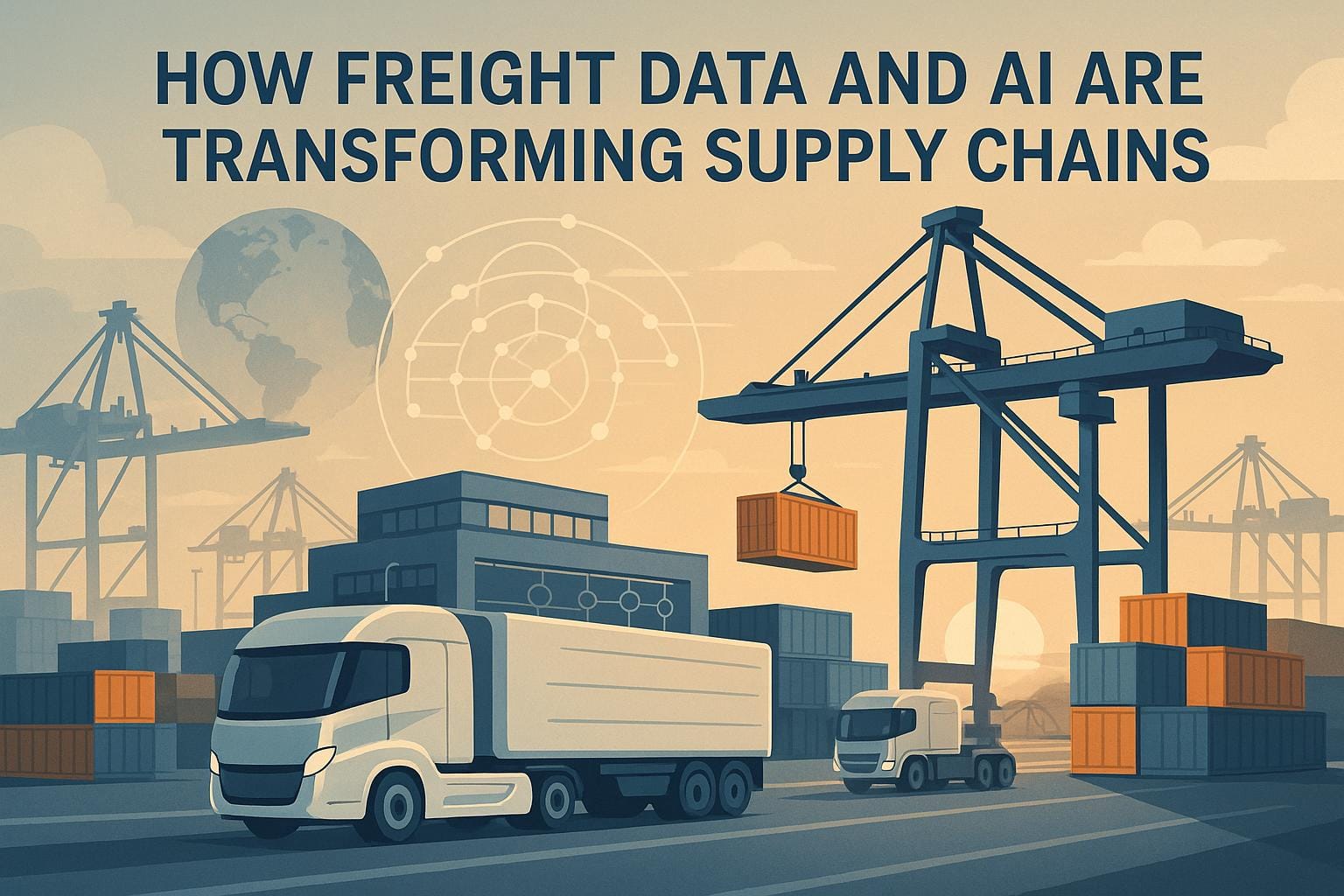How Freight Data and AI Are Transforming Supply Chains
Explore how AI and freight data are revolutionizing supply chains, driving insights, and enabling smarter logistics decisions.

The supply chain is the backbone of the global economy, responsible for ensuring that goods move seamlessly from manufacturers to consumers. In a rapidly transforming world, the integration of freight data and artificial intelligence (AI) is reshaping how supply chains operate. Leaders in logistics, infrastructure, and data resilience sectors - especially those in the Gulf Cooperation Council (GCC) - have much to gain by understanding these trends. This article analyses transformative insights from Prologis Ventures' Will O'Donnell and FreightWaves' Craig Fuller, highlighting how technology and strategic frameworks can redefine supply chain management.
The Vital Role of Freight Data: A "Source of Truth" for the Goods Economy
Freight data offers a unique lens into the global and local economies. As Craig Fuller aptly pointed out, "freight is the source of truth for the goods economy." Every physical product consumed must pass through a transportation network, making freight data a real-time indicator of economic activity. Unlike financial metrics like GDP or retail sales that lag behind events, freight data provides immediate insights into the volume and movement of goods.
Freight as a Commodity: A Key Differentiator
Unlike other commodities such as oil or wheat, freight cannot be stored or stockpiled. Movement only occurs when there is active demand on the other end. This makes freight data a leading indicator of market health. For example, the volume of flatbed trucks transporting materials like steel or lumber can be directly correlated with housing starts or construction activity.
In the GCC, where infrastructure projects are a cornerstone of economic diversification, monitoring localized freight data could provide insights into the pace of urban development. Decision-makers in logistics can use such data to anticipate demand shifts and allocate resources efficiently.
Leveraging Data for Economic Insights
Freight data goes beyond raw figures - it provides macro and microeconomic insights. Prologis Ventures emphasizes how tools like outbound tender volume indexes (OTVI) and tender rejection indexes offer a granular understanding of the market.
Outbound Tender Volume Index (OTVI)
OTVI tracks the volume of transactions between shippers (e.g., retailers, manufacturers) and carriers (e.g., trucking companies or third-party logistics firms). By indexing these figures, decision-makers can assess whether demand is rising or falling in near real-time. In the GCC, where retail and e-commerce sectors are booming, analyzing tender volume can help key players predict inventory needs and supply chain bottlenecks.
Tender Rejection Index
The tender rejection index measures how frequently truckers decline shipping orders. A high rejection rate typically indicates strong trucking demand and better pricing power for carriers, while a low rejection rate signals softer market conditions. This metric is vital for managing operational costs and ensuring supply chain resilience, particularly in volatile markets.
AI: Transforming Supply Chain Resilience and Efficiency
Artificial intelligence is poised to revolutionize the freight industry, but the adoption of AI comes with its own set of challenges and opportunities. Fuller and O'Donnell explored how AI can provide actionable intelligence by processing vast amounts of data and identifying patterns.
Strengths of AI in Freight Management
AI excels in areas like contextualizing data, automating repetitive tasks, and exception management. For instance:
- Automation of Routine Processes: AI can handle the bulk of logistics monitoring, alerting humans only when exceptions arise.
- Contextual Insights: Sophisticated algorithms can translate raw freight data into actionable insights tailored for specific industries or geographies.
For GCC enterprises and policymakers, this means AI can help navigate complex logistics scenarios, such as cross-border trade or compliance with regional regulations. AI-powered tools can also bolster sovereign data initiatives by offering localized insights into freight movements and supply chain dependencies.
Current Limitations of AI
Despite its potential, AI is not yet adept at managing time-series data or forecasting. Fuller notes that many language models struggle to integrate daily data updates and may provide inconsistent or outdated predictions. Supply chains, which thrive on real-time visibility, require AI systems that can adapt to changing conditions and incorporate human oversight.
Building Resilient Supply Chains in an Era of Disruption
The global freight industry is increasingly subject to disruption, from geopolitical tensions to natural disasters. In this context, resilience is no longer optional - it’s essential. Craig Fuller highlighted the importance of contingency planning and investment in data infrastructure to weather disruptions.
Key Strategies for GCC Decision-Makers
- Data-Driven Decision-Making: Invest in tools and platforms that provide real-time freight data to anticipate disruptions and identify opportunities.
- Scenario Planning: Develop contingency strategies for potential disruptions, such as shifts in trade routes or regulatory changes.
- Leverage Local Expertise: Experienced teams with in-depth knowledge of GCC markets and logistics networks can navigate challenges more effectively.
- Adopt AI Responsibly: While AI can enhance decision-making, human expertise remains critical for managing unforeseen events and complex geopolitical scenarios.
Innovating with Adjacent Learnings
One of the most insightful points from the discussion was the value of applying lessons from adjacent industries to the freight sector. Successful entrepreneurs like Jordan Graph of Highway have blended expertise from banking (fraud detection) with freight management, demonstrating how cross-sector innovation can drive breakthroughs.
For GCC logistics leaders, this approach could mean looking at how industries such as fintech, healthcare, or energy manage complexity and applying those strategies to freight management. Sovereign cloud initiatives and hyperscalers can further support such innovation by providing the computational power and secure data environments needed for AI development.
The Path Forward: Embracing Change and Technology
The freight industry is at a crossroads. As we navigate an era marked by uncertainty and disruption, the convergence of freight data and AI offers unparalleled opportunities to enhance supply chain resilience and efficiency. However, success requires a balanced approach - embracing technology without neglecting the value of human expertise.
For decision-makers in the GCC, the message is clear: Invest in data, embrace innovation, and prepare for a more complex - but opportunity-rich - future.
Key Takeaways
- Freight Data’s Critical Role: Freight data is a real-time indicator of economic activity, offering localized and global insights into goods movements.
- AI in Supply Chains: AI can transform logistics by automating routine tasks, providing contextual insights, and enhancing exception management.
- Limitations of AI: Current AI models struggle with time-series data and forecasting, emphasizing the need for human oversight.
- Resilience through Planning: Disruption is inevitable; contingency planning and investment in data are essential for supply chain resilience.
- Adjacent Learnings: Borrowing strategies from other industries can spark innovation in the freight sector.
- GCC-Specific Insights: Freight data can be leveraged to monitor infrastructure growth, retail trends, and supply chain dependencies in the region.
- The Human Factor: Experienced teams remain critical for navigating complex logistics challenges.
By harnessing the power of freight data and AI while prioritizing strategic foresight, GCC leaders can position their organizations as pioneers in the future of logistics. The tools are available - the opportunity is now.
Source: "Smart Freight: How AI and Data Are Reshaping Supply Chains" - Prologis, YouTube, Sep 2, 2025 - https://www.youtube.com/watch?v=6MiT-EfK1iU
Use: Embedded for reference. Brief quotes used for commentary/review.
